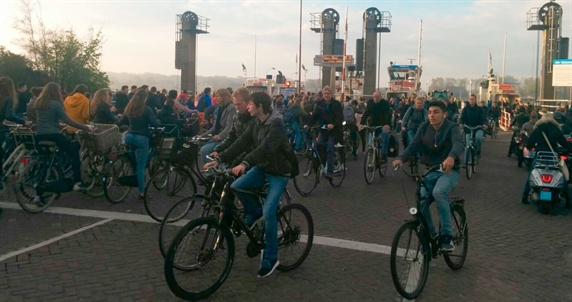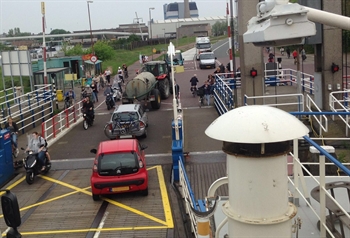Case study Deployment of a ferry at the Velser tunnel
In 2016, the Velser tunnel (A22) was closed for nine months for large-scale refurbishment. Every day, 65,000 vehicles pass through the Velser tunnel. Rijkswaterstaat and various parties in the surrounding area were looking for an alternative. Together they drew up and implemented an accessibility plan.
The plan consisted of various measures in the area of traffic management, additional infrastructure, mobility management and communication. One crucial measure was the deployment of an extra rush-hour ferry between Velsen-Noord and Velsen-Zuid.
The North Sea Canal is a natural barrier in the IJmond region. Many people live on one side and work or go to school on the other. Because of the short distances, many of them travel by bike. That is why the project team paid a great deal of attention to the accessibility of the IJmond region for cyclists during the closure of the Velser tunnel.
The idea was that cycling would be faster than making a detour through the busy Wijker tunnel. So partly at the request of Rijkswaterstaat, IJmond Bereikbaar deployed an extra rush-hour ferry and implemented an extensive cycling incentive programme.

The project
One important condition for the success of the incentive programme was an extra rush-hour ferry. This halved waiting times for cyclists and made cycling trips even more attractive. Thanks to the extra ferry, there was now one ferry departing in either direction every ten minutes instead of every twenty minutes.
Cyclists could use the ferry service for free and all motorised traffic on payment. Bus passengers on one Connexxion service also travelled by ferry during the closure of the Velser tunnel. Occasionally, the ferry was also used flexibly, for example by continuing to sail for an hour longer in order to cope with congestion following an incident on the main road network.
Implementation
Rijkswaterstaat provided the rush-hour ferry in collaboration with IJmond Bereikbaar and the Municipality of Velsen. In order to make this possible, they made sustainable modifications to the two ferry terminals prior to the closure of the Velser tunnel to prepare for the extra bicycle traffic. The municipal transport company GVB, which operated the rush-hour ferry, also modified the layout of the decks so that it could safely transport the larger numbers of cyclists, scooters and motorised traffic.
For the project, Rijkswaterstaat and IJmond Bereikbaar concluded a management agreement valued at €2 million with the Velser tunnel Refurbishment Project. IJmond Bereikbaar also received an Optimising Use grant .
This was used to fund the extra rush-hour ferry and the cycling incentive programme. In the cycling incentive programme, participants (about 3,000) received an allowance for each kilometre cycled between home and work. The total package also included the deployment of the public transport bike (OV-fiets), the IJmond Shuttle, and webcams to monitor the traffic situation.
Results
During the closure of the Velser tunnel, the number of passengers using the ferry was closely monitored. With an average of 5,500 passengers per day, ferry use was 40% higher than normal during that period. After the reopening of the Velser tunnel, this was still 15% higher than before the closure. The use of two ferries also increased the reliability of the service.
Moreover, the ferry is very popular with travellers. 83% of IJmond Bereikbaar's participating cyclists consider the bicycle ferry important. At every external meeting held by the project team, it was said that the ferry was very much appreciated. Partly because of this, support for the refurbishment and closure of the Velser tunnel was high.
Considerations for deployment elsewhere
The deployment of a (bicycle) ferry depends entirely on the situation and location. You can read more about accessibility effects in the fact sheet Deployment of Ferries. The Velser ferry was successful
due to:
- the fact that it coincided with the closure of a motorway tunnel
- the extensive package of cycling incentives
- distances in the IJmond being easily cover by bicycle
For Rijkswaterstaat, the rush-hour ferry made an important contribution to the accessibility of the IJmond during the refurbishment of the Velser tunnel. At the same time, the ferry proved its worth to the Municipality of Velsen and IJmond Bereikbaar as an important link in the regional fast cycle route. So they decided to deploy the extra rush-hour ferry for a longer period. The ferry will be in operation until at least the end of 2018, after which there is no guarantee of continued funding.

